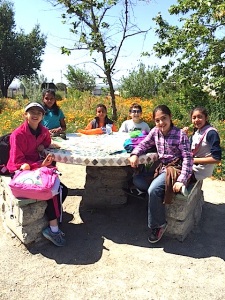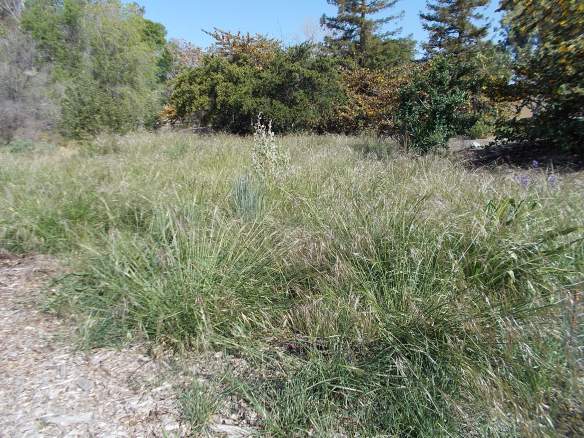“Once there were fields of grass waving tall in the wind as far as the eye could see. The Spanish travelers came and described them – the finest pasture, an abundance of pasture, enough for all the flocks and herds. They brought their cattle and sheep, their horses and mules, and with them the weedy plants. They began a process of change and a devastation that was left to us as a legacy. The needle grasses and wild rye disappeared and we were left with foxtail and Medusa’s head. The June grass, blue grass and poppies have gone. We have inherited the poverty grass, tarweed and thistle.” – Raymond F. Dasmann, The Destruction of California
 The majestic and widespread grasslands that carpeted the California land- cape for centuries before the European invasion are gone. But the individual grasses are still here, and in recognition of their historical and environ- mental importance, the Cali- fornia legislature in 2004 declared that the most domi- nant native grass, purple needlegrass (Stipa pulchra, formerly known as Nassella pulchra), as the official state grass. (Remember that a photo can usually be enlarged just by clicking on it.)
The majestic and widespread grasslands that carpeted the California land- cape for centuries before the European invasion are gone. But the individual grasses are still here, and in recognition of their historical and environ- mental importance, the Cali- fornia legislature in 2004 declared that the most domi- nant native grass, purple needlegrass (Stipa pulchra, formerly known as Nassella pulchra), as the official state grass. (Remember that a photo can usually be enlarged just by clicking on it.)
Why Purple Needlegrass? Even tho most people have probably never heard of purple needlegrass, this grass was selected for many good reasons. For one, it was the most widespread perennial native grass found on the grasslands of California before the alien annual grasses were introduced from other countries. It is still the most common native bunchgrass in places where it has not been crowded out by the alien non-natives. The flowers have a slight purple cast when they are young, but from a distance a field of needlegrass can have a silvery sheen. Its roots may go down as far as 16 feet where it can find water to survive the dry California summers. Its large, fibrous root system makes it useful for preventing soil erosion in sites with poor soil conditions and low fertility. It provided valuable forage for deer, elk and other wildlife. So it is an excellent representative of California’s heritage.
So it is an excellent representative of California’s heritage.
An acre of purple needlegrass may yield 200 or more pounds of seed. This prolificacy made it an important food source for the Native Americans, who would store the dry seeds for months, then toast them or grind them up to make a pinole. If the dry grass was burned in the fall, it tended to produce an even more abundant seed crop the following year. And it is the grass preferred by the California Indian Basketweavers Association for teaching children the art of basket weaving.
 And … It Even Plants Itself! The needlegrass seed is attached to a very long stiff hair or bristle (awn) which develops two bends when the seed and awn dries out. Changes in the moisture of the air between night and day cause the awn to alternately twist and unwind until it manages to strike the soil. Over several days, this causes the seed attached to the awn to push downward into the soil. Stiff hairs on the seed are pointed backward and prevent the seed from backing out. This also protects it from birds and mice as well as from any wildfire that might sweep over the grassland. So the seed doesn’t just fall to the ground and take its chances – it actually plants itself! (Unfortunately, it also plants itself in your clothing as you walk thru it, and in your dog’s fur where it can work its way into the animal’s skin.)
And … It Even Plants Itself! The needlegrass seed is attached to a very long stiff hair or bristle (awn) which develops two bends when the seed and awn dries out. Changes in the moisture of the air between night and day cause the awn to alternately twist and unwind until it manages to strike the soil. Over several days, this causes the seed attached to the awn to push downward into the soil. Stiff hairs on the seed are pointed backward and prevent the seed from backing out. This also protects it from birds and mice as well as from any wildfire that might sweep over the grassland. So the seed doesn’t just fall to the ground and take its chances – it actually plants itself! (Unfortunately, it also plants itself in your clothing as you walk thru it, and in your dog’s fur where it can work its way into the animal’s skin.)
 Smith School Visits the Granada Native Garden Jo Lucas’s 5th grade science class from Smith School, in Livermore, spent the morning at the Garden recently. This was a good time, because so many flowers are in bloom and the weather was so agreeable. They toured all four plant communities of the Garden, learned about flower parts and flower reproduction, and explored the sticky wonders of our gumplant (Grindelia sp.). Finally, the three mosaic tables at the Garden provided a good place to enjoy their lunch.
Smith School Visits the Granada Native Garden Jo Lucas’s 5th grade science class from Smith School, in Livermore, spent the morning at the Garden recently. This was a good time, because so many flowers are in bloom and the weather was so agreeable. They toured all four plant communities of the Garden, learned about flower parts and flower reproduction, and explored the sticky wonders of our gumplant (Grindelia sp.). Finally, the three mosaic tables at the Garden provided a good place to enjoy their lunch.
Quote du Jour “(Steve and Laurene Jobs) had planted wild grasses native to Northern California around the perimeter of the property. Some neighbors grumbled at first, but most came to appreciate the way the color and character of the vegetation would change with the seasons. In spring the plantings would explode with wildflowers, and in summer the untrimmed clumps of grass would shimmer in the wind.” – Brent Schlender & Rick Tetzell, in Becoming Steve Jobs, p. 148
♥ Special thanks to Lewis Reed, PhD, for his professional information about purple needlegrass, and to Fremontia: A Journal of the California Native Plant Society, Vol.9(1):3-6, 1981, for the illustration of the needlegrass seed.
Changes in the GNG’s EMail Address Due to unexplained technical complications, the email address to Jim at the Garden has undergone a couple of changes. The new email address is: JIMatGNG@gmail.com. This will not affect comments that are sent related to the Newsletter.


